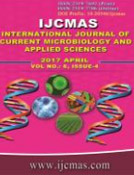


 National Academy of Agricultural Sciences (NAAS)
National Academy of Agricultural Sciences (NAAS)

|
PRINT ISSN : 2319-7692
Online ISSN : 2319-7706 Issues : 12 per year Publisher : Excellent Publishers Email : editorijcmas@gmail.com / submit@ijcmas.com Editor-in-chief: Dr.M.Prakash Index Copernicus ICV 2018: 95.39 NAAS RATING 2020: 5.38 |
A study was conducted at Crop Research Center of G.B. pant University of Agriculture and Technology, Pantnagar in Tarai region of Uttarakhand, India to quantify nitrous oxide emission from rice fields due to the addition of different organic amendments and inorganic fertilizers. The average nitrous fluxes for rice were 0.57, 1.87, 2.37, 3.52 and 1.27 mg m-2 h-1 from control with crop, farmyard manure (FYM), green manure (GM), straw amendments and sulphur fertilizers, respectively. Among different growth stages of rice transplanting to tillering growth stage nitrous oxide flux was maximum in straw amendment, 5.79 mg m-2 h-1 while lowest in control 0.53 mg m-2 h-1. After that, during tillering highest flux was 3.58 mg m-2 h-1, with lowest in control 0.79 mg m-2 h-1. During reproductive to ripening growth stage nitrous oxide flux was highest in straw amendments, 2.72 mg m-2 h-1, followed by GM amendments, 2.47 mg m-2 h-1, FYM amendments, 1.47 mg m-2 h-1, sulphurus fertilizers 0.95 mg m-2 h-1, and the lowest was in control with crop, 0.35 mg m-2 h-1. Lastly ripening to maturity growth stage nitrous oxide flux was highest in GM amendments, 1.69 mg m-2 h-1, followed by FYM amendments, 1.18 mg m-2 h-1, straw amendments, 0.42 mg m-2 h-1, sulphurus fertilizer, 0.43 mg m-2 h-1, and the lowest was in control with crop, 0.38 mg m-2 h-1. The results indicated that nitrous oxide emission was enhanced by undecomposed organic amendments (straw and green manure) as compared to well-decomposed organic amendments (farmyard manure) and sulphurus fertilizers.
 |
 |
 |
 |
 |